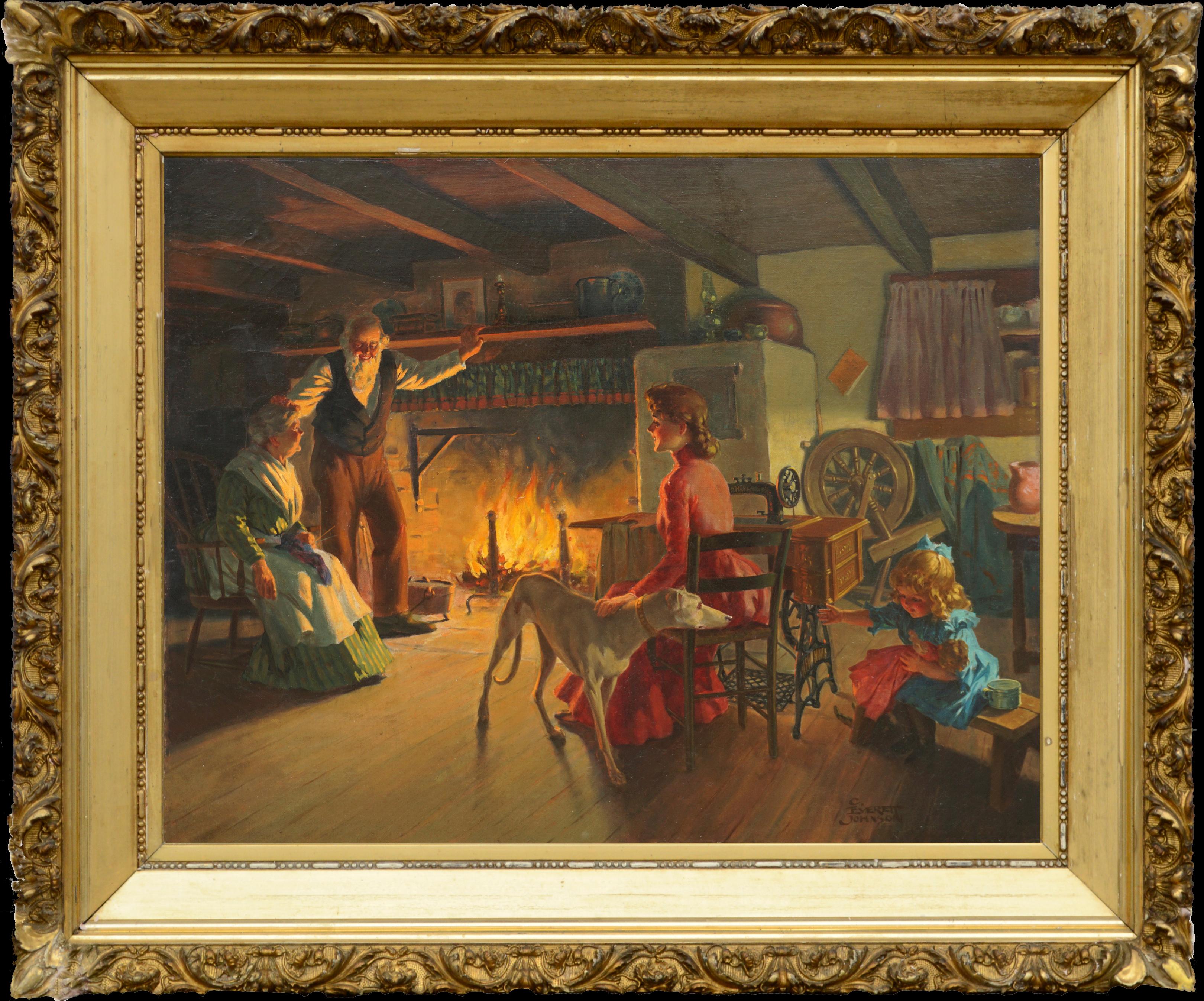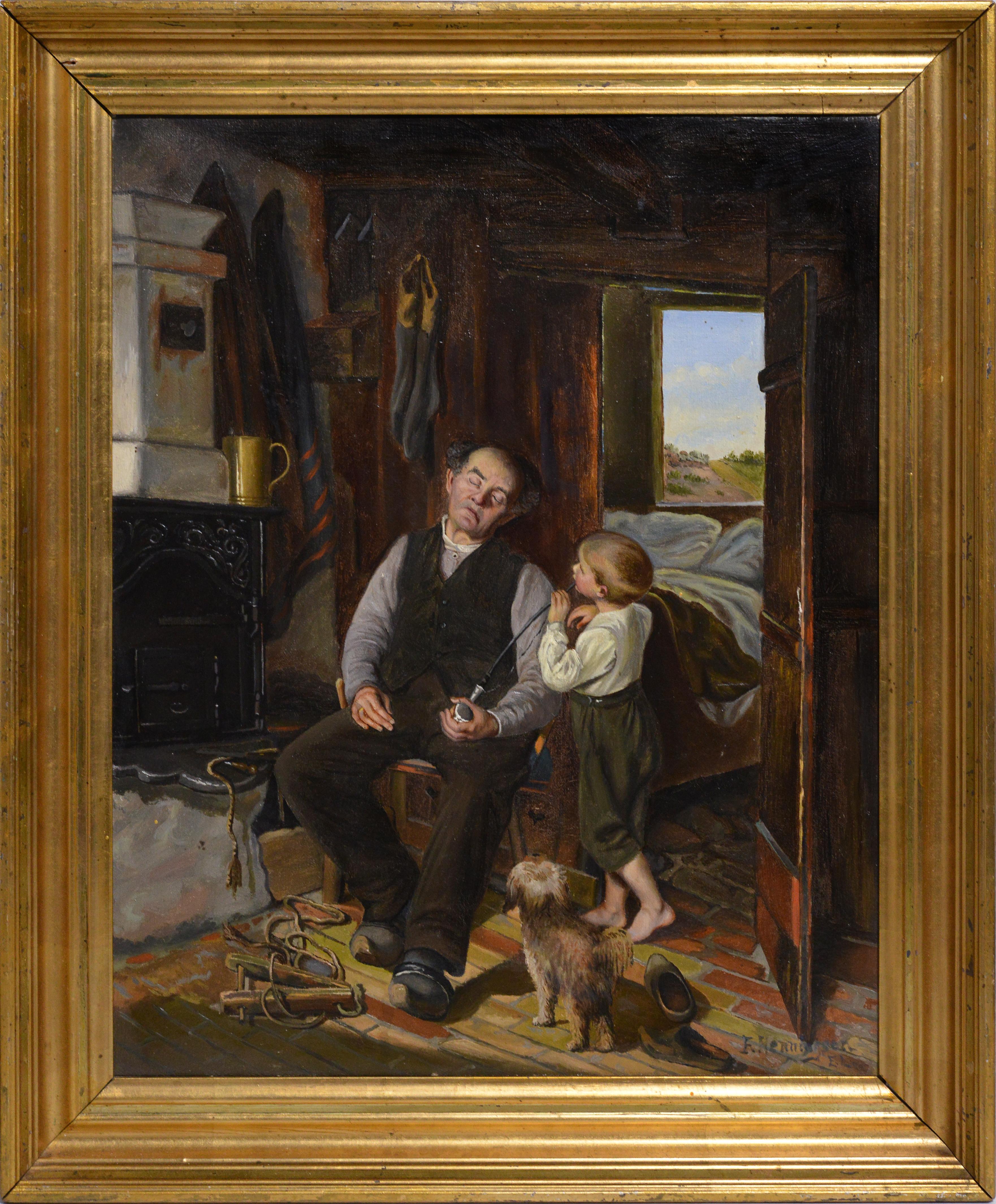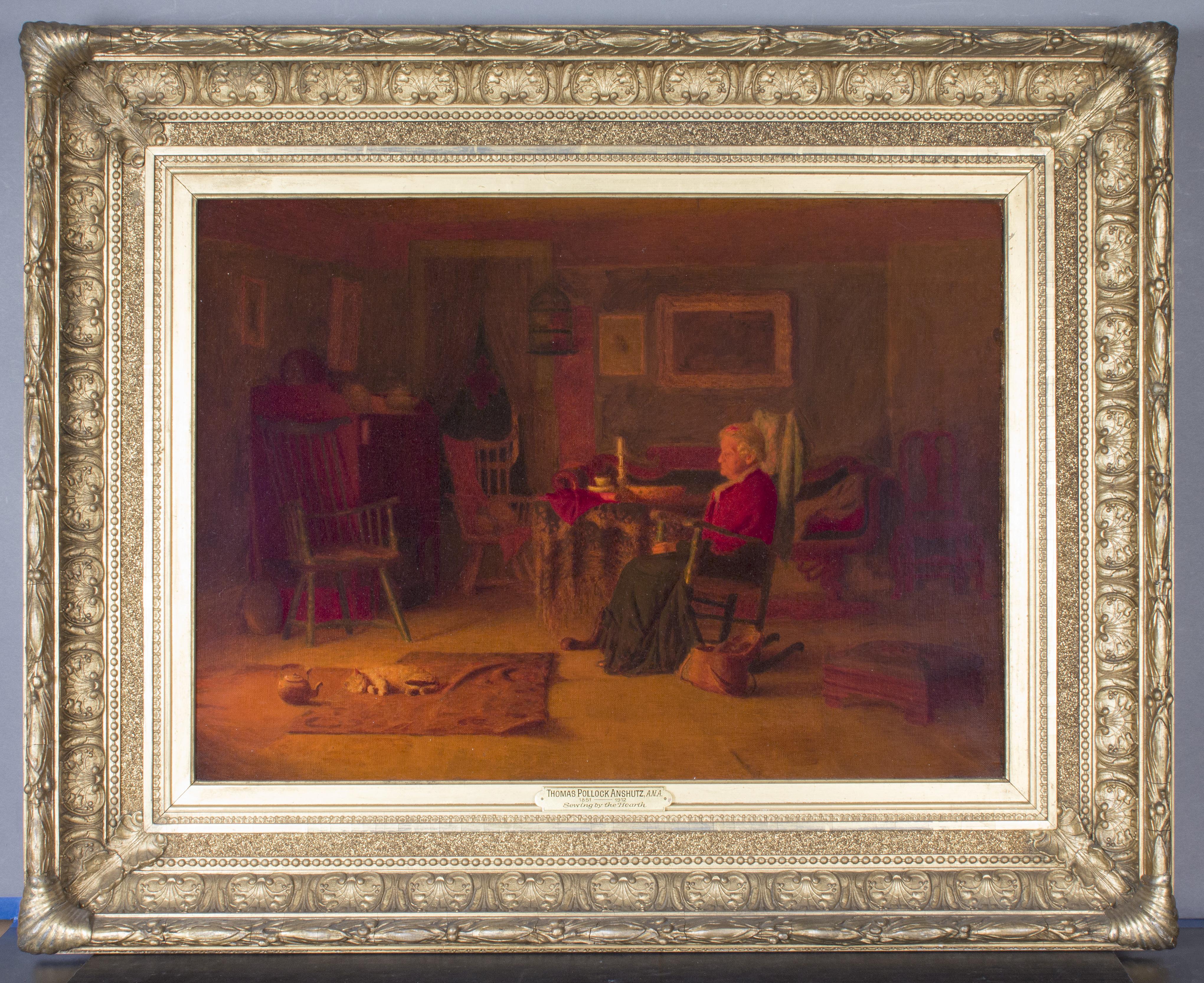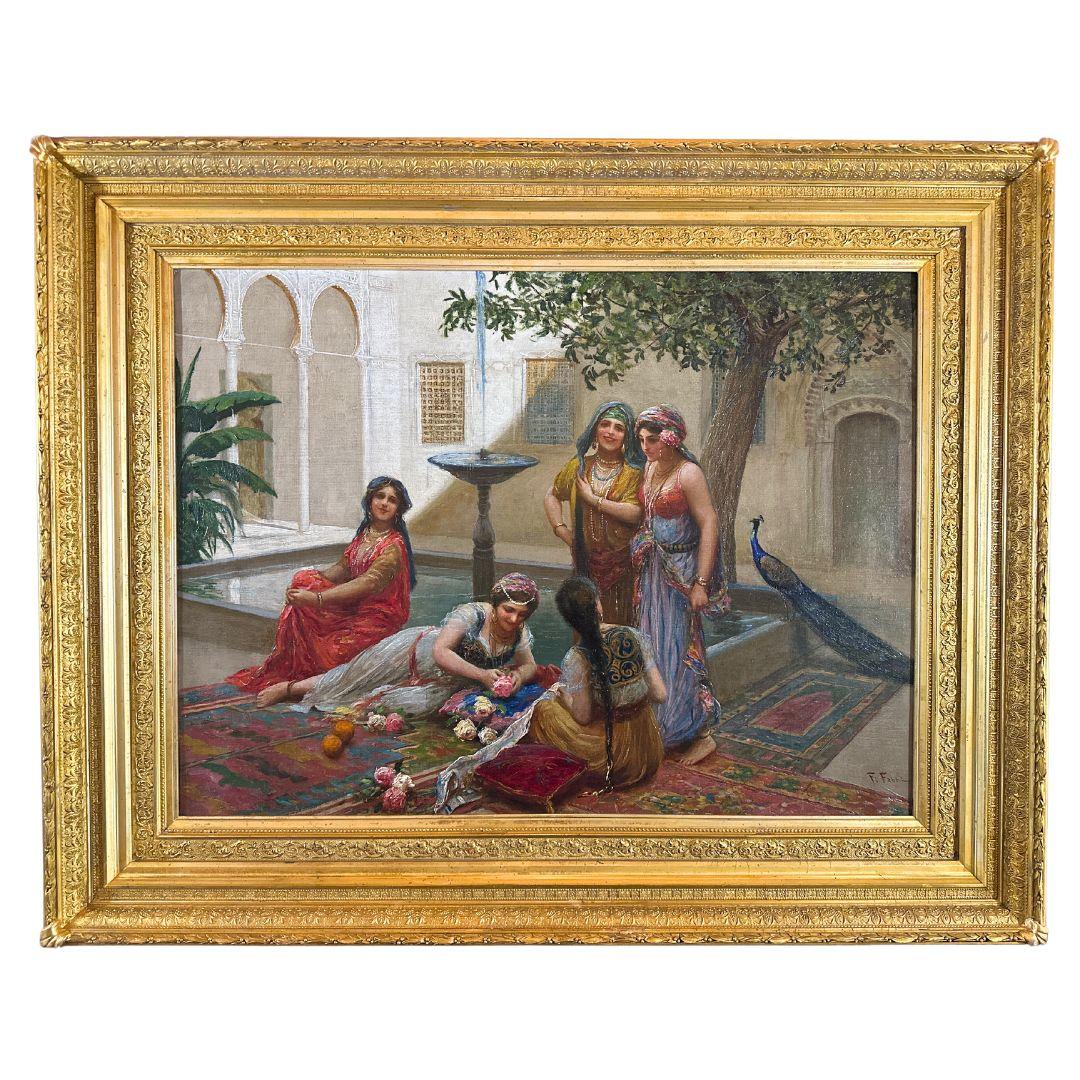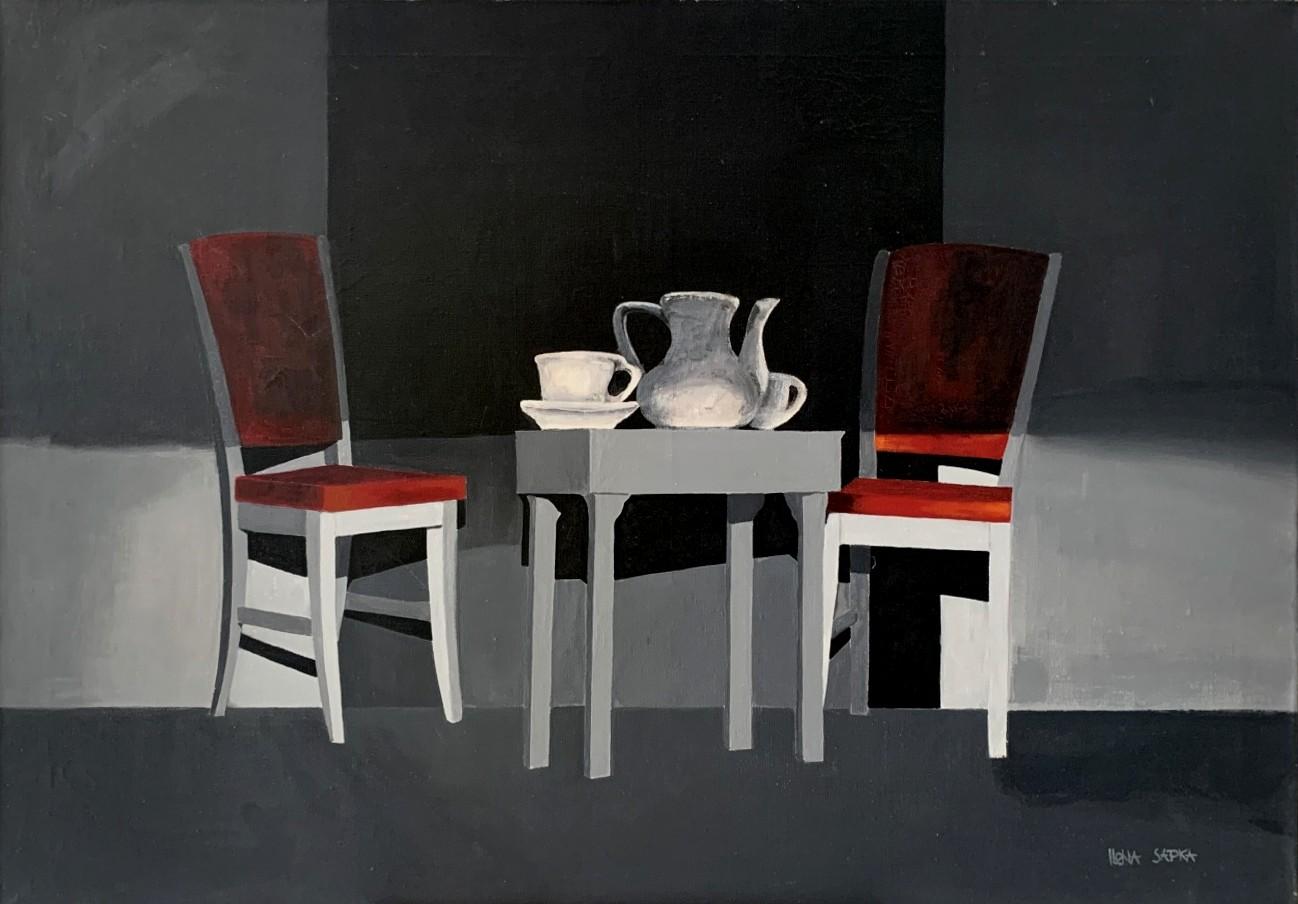Items Similar to A Jolly Time -- German Genre Tavern Painting, 1918
Want more images or videos?
Request additional images or videos from the seller
1 of 10
Karl Josef MullerA Jolly Time -- German Genre Tavern Painting, 19181918
1918
About the Item
Wonderful German genre painting of 17th century tavern scene in style of Franz Hals by Karl Josef Muller (German, 1864-1942) dated 1918. Signed and dated lower left corner "Karl Muller - Hamburg 1918". Condition: Good; professionally restored: Canvas restreched on new stretcher bars; five repairs made to small tears in canvas (see image); cleaned and re-varnished with UV-resistant varnish. Unframed. Image size: 39.5"H x 55"W. We have the original frame which needs some extensive repair to the gesso. Happy to include the frame with the painting as is.
Karl Müller was born in Hamburg-Altstadt in 1865. His wealthy Jewish parents Abraham Müller (1832-1896), citizen of the Hanseatic city since 1869, and Henriette "Jette", b. Burchard (born 1832 Neubuckow / Mecklenburg), had a cigar factory at Spielbudenplatz 5 in St.Pauli. When Karl Müller was ten years old, next to factory and warehouse, now at Speersort 11 (Altstadt), there was also a branch in Altona-Ottensen with the address Am Felde 68. The family lived at the time at Pferdemarkt 13 (Old Town).
After attending the Jewish Foundation School at the Zeughausmarkt, Karl Müller completed a three-year lithography apprenticeship. From 1886 to 1888, he studied at the Royal Saxon School of Applied Arts in Dresden with the history and decoration painter Donadini, then with Professor Hanke of the Prussian Academy of Arts in Berlin.
Karl Müller's painting style was conventional-realistic and did not follow modern trends. In 1891, the oil paintings "Preparation for the Service", "In the guardroom", tattoo", "gymnastics lesson", "covert patrol” and "return from the field service exercise”, whose main motive almost always soldiers formed.In 1893, he painted the" invasion of the 76er " as a horizontal format in black and white, the painting was acquired by the Museum of Hamburg History in 1930. The disposition of Karl Müller could be classified as "kaisertreu" and "national" (Maike Bruhns) at this time - not by chance he acted with his Nicknamed "Soldatenmüller", he successfully participated in exhibitions in Berlin and Hamburg before the turn of the century.
Even at this time, the frequent change of residence is striking: 1893 Papendamm 25 (Rotherbaum), 1896 Bundesstraße 9 (Rotherbaum). In 1898 he was in the Hamburg address book as a "genre and portrait painter" with the residential address 1. average 43 (Rotherbaum) out.
At the age of 38, Karl married in 1903 in the Hanseatic city of the Jewish Louise Hauer (born 12.2.1872 in Hamburg), called "Lieschen". Before her marriage, she lived with her mother at Grindelberg 78. Her father, Martin Hauer (1836-1897), also born in Hamburg and was a citizen of the city since 1862, owned a factory for soap and perfume. In 1904 and 1911, the two daughters Karla and Lotte were born.
1904, the family lived at this time in the Bogenstraße 20, Karl Müller commissioned a portrait of the emigrated hamburger Henry Jones opening the same lodge in the Hartungstraße 9-11. Already at this time he might have been a member of the Hamburg Artists Association of 1832.
Starting from 1908 further change of dwellings on the basis of the telephone books are comprehensible: nearly yearly the family moved and moved thereby from the Grindel quarter over Hoheluft east to Harvestehude and Winterhude. Around 1912 she moved into an apartment in Sierichstraße 156. Here, the landlord Schröder provided the artist with an area of around 45 square meters as a studio on the dry floor. But the building police criticized this use and after some disputes, the painter had to move once again with family and studio. The official telephone directory recorded as an address from 1914 to 1918 Klosterallee 20 (Harvestehude).
Friedrich Jansa described Karl Müller's changed motif choice in his artist's glossary in 1912: "In recent years he has been watercolouring a lot in the Hamburg area and now mainly takes his motifs from Hamburg harbor life." All of his works are privately owned. " Landscapes, portraits, harbor scenes and folk life were created. Karl Müller did not participate in World War I for reasons of age.
After 1918, the public's interest in Müller's soldier paintings disappeared. The art dealer Karl Heumann recalled in 1951 in a letter to the daughter, which was forwarded to the Office for Reparation: "I met your father shortly after the First World War, when I was managing director of the Kunstsalon Krone There were also a number of pictures of him in and out of the shop, which, as I recall, were only soldiers' pictures, maneuvers, bivouacs, etc., which I first saw here, but with the lost war, too the preference for such pictures away. "
In 1919, the naturalistic image "Old Drivers" or "Lotsenzimmer", which the Museum of Hamburg History acquired in 1964, was created.
From July 1919 to 1932 the family of four lived according to a telephone directory in Bieberstraße 9, I. Stock (Rotherbaum). By the inflation of 1923 she lost her savings. The financial situation worsened after the 1929 economic crisis. For the years 1929 to 1933, no payments were noted in the column of Karl Müller's Kultussteuerkartei card of the Jewish community. Relatives supported the family, which since 1933 lived in very limited economic conditions. The younger unmarried daughter Lotte was dismissed in 1933 at the Berlin State Theater for "racial" reasons.
The Reichskulturkammer, founded by law in September 1933, with its seven individual chambers, was a compulsory organization for artists, but made the membership dependent on an "Aryan proof". The non-membership meant de facto a professional and publishing ban for the artist. Nevertheless, published in its evening edition of January 6, 1934, the "Hamburger Fremdenblatt" a page with soldier paintings by Karl Müller, whose popular military presentation now again corresponded to the taste of the time. However, it had escaped the notice that the painter was not allowed to publish for "racial" reasons.
In the short term, Karl and Louise Müller moved into a flat in Schwenckestraße 54 III (Eimsbüttel). From 1933 to 1937 a telephone connection for the Cäcilienstraße 6 parterre (Winterhude) with the reference "painter" was registered. In order to obtain suitable premises for painting, Karl Müller built a simple wooden shed in the backyard in the summer of 1933, the roof of which reached below the windowsill of Müller's ground floor apartment. Since Karl Müller was a welfare recipient and had almost no own income left, he was granted the due approval fee of 10 RM. In October 1937, the couple moved to Gryphiusstraße 7 in Winterhude. Now Karl Müller got involved in the Jewish Culture Federation Hamburg. The last place of residence in Hamburg was an apartment in the Martin-Brunn-Stift at Frickestraße 24 in Eppendorf, which had to fulfill the function of a "deportation collective" as a "Judenhaus".
The art dealer Heumann later told the Reparations Office that he had visited Karl Muller on Frickestrasse "after receiving a letter from him asking me to assist him in sending a large number of studies and pictures abroad At that time (and now there is again) there was a law according to which paintings, which would mean an irreplaceable loss to German national artistic property, could not be readily exported, whether Jewish or Aryan property After so many years of remembering that he wanted to send the pictures to Japan, I suspect that the freight forwarder has probably pointed out this legal provision to him, and as far as I can remember I have written to him confirmation that there are no reservations about the export of his pictures (...) I do not know if the expedition of the pictures abroad is done (...) ".
The couple Müller was deported on July 15, 1942 from Frickestraße 24 with "Transport VI / 1" to the ghetto Theresienstadt. There they arrived on July 19, 1942. Karl Müller died according to the death report in the "Central Hospital Rooms 9" on 20 October 1942 to "heart failure".The artist's encyclopaedia Rump states that he starved in Theresienstadt.
Louise Rebecca Müller was deported on May 15, 1944 from the ghetto Theresienstadt to the extermination camp Auschwitz, her exact date of death is unknown. For the calculation of the indemnity claims was set by the court of May 8, 1945 as the date of death.
- Creator:Karl Josef Muller (1864 - 1942)
- Creation Year:1918
- Dimensions:Height: 39.5 in (100.33 cm)Width: 55 in (139.7 cm)Depth: 1 in (2.54 cm)
- Medium:
- Movement & Style:
- Period:
- Framing:Framing Options Available
- Condition:Professionally restored: five repairs made to small tears in canvas (see image); cleaned and varnished with UV-resistant varnish.
- Gallery Location:Soquel, CA
- Reference Number:
About the Seller
5.0
Platinum Seller
These expertly vetted sellers are 1stDibs' most experienced sellers and are rated highest by our customers.
Established in 1986
1stDibs seller since 2014
2,506 sales on 1stDibs
Typical response time: <1 hour
- ShippingRetrieving quote...Ships From: Soquel, CA
- Return PolicyA return for this item may be initiated within 14 days of delivery.
More From This SellerView All
- "The Family Hearth" - Turn of the Century Cozy Interior Figurative SceneBy Charles Everett JohnsonLocated in Soquel, CACharming turn-of-20th Century interior painting that takes the viewer back to simpler times with grandmother, grandfather, mother sewing and a young girl playing with her greyhound a...Category
Early 1900s Realist Interior Paintings
MaterialsLinen, Oil
- 17th Century Genre Painting -- The Pipe SmokerBy Flemish School, 17th CenturyLocated in Soquel, CAWonderful genre painting from 18th Century of pipe smoker. Signed lower right edge with monogram "I I E". Oil paint on copper. Condition: good: minor wear/rubbing from frame's rabbet...Category
Mid-17th Century Realist Figurative Paintings
MaterialsCopper
- Portrait of the Artist Manuel Neri Heavy Impasto on Linen San Francisco AbstractBy Honora BergLocated in Soquel, CAPortrait of the Artist Manuel Neri Heavy Impasto on Linen San Francisco Abstract San Francisco Abstract Expressionist School a portrait by Honora Berg (American, 1897 - 1985). Heavy impasto with broad strokes an interior scene with the iconic San Francisco sculptor Manuel Neri. Honora captures Manuel's distinctive features with her expressionist style and layered paints. Manuel is in a dark suit and bright shirt and tie resting his arm on the window and looking out at the trees in the distance. Provenance, Estate of Honora Berg - David Carlson Gallery, Larry Miller...Category
1960s Abstract Impressionist Figurative Paintings
MaterialsOil, Linen
- Sleeping Spaniel in the Hearth Italian Figural Dog Painting oil on LinenBy Tito CorbellaLocated in Soquel, CASleeping Spaniel in the Hearth Italian Figural Dog Painting oil on Linen Exceptional painting of a sleeping Spaniel in a Hearth by Italian artist Tito Corbella (Italy, 1885-1966), we...Category
1920s Impressionist Figurative Paintings
MaterialsLinen, Oil
- "Happy Family", Mid Century Sepia Figurative Interior Scene, Illustration ArtLocated in Soquel, CA"Happy Family", Mid Century Sepia Figurative Interior Scene, Illustration Art by Charles Kinghan A classic and heartwarming mid-century sepia toned figurative interior scene by Charles Ross Kinghan (American, 1895-1984). Circa 1940's. This mid-century piece exemplifies the classic style of illustrations and advertisements from the period, and depicts a family gathered in their living room. Signed "Kinghan" in the lower right corner. Acquired with other works by the artist. Displayed in a period giltwood frame. Linen size: 36"H x 30"W. Framed size: 45"H x 38.5"W x 2"D. Charles Ross Kinghan (American, 1895-1984) was born in Anthony, KS on January 18, 1895. A teacher, he moved to Wichita as a teenager and did sign painting for the Western Sign...Category
Mid-20th Century American Impressionist Figurative Paintings
MaterialsLinen, Oil
- Portrait of a Man in Armchair, Mid Century Short Story IllustrationLocated in Soquel, CAExcellent figurative oil painting of a man seated in an armchair with papers strewn about the interior space by Charles Ross Kinghan (American, 1895-1984). A working illustration pai...Category
1930s American Impressionist Figurative Paintings
MaterialsLinen, Oil
You May Also Like
- Grandpa and Naughty Boy Danish Master Genre Scene 19th century Signed FramedBy Erik Ludwig HenningsenLocated in Stockholm, SESigned lower right “Henningsen” and dated 1881 at reverse. Attributed by Erik Ludvig Henningsen (1855 - 1930) was a Danish painter and illustrator. Masterly painted genre scene “testing grandfather’s pipe” depicting lively domestic moment. The little prankster wants to be like his grandfather, but how can he not try his grandfather’s pipe, which he loves so much and does not let go of even in his sleep. The curious and brave sly man, despite the consequences, took off his shoes to approach quietly... One can imagine his disappointment and emotions after he accomplished what he had planned... The boy's faithful friend, a small dog, looks at all this with interest and curiosity. Loved and admired for his talent to realistically portray life and tell a story at the same time, Henningsen took great pride to never include any personal feelings or philosophy, but to stay neutral to the subject matter for whichever painting he was doing. Antique oil painting on canvas, signed, framed. Size: 43 cm x 35 cm (roughly 16.9 x 13.8 in), frame 52 x 43.5 cm (roughly 20.5 x 17.1 in). Very Good pristine condition with minimal wear. Please study good resolution images for cosmetic condition. In person actual painting may appear darker or brighter than in our pictures, strictly depending on sufficient light in your environment. Weight of app. 1 kg is going to measure some 2 kg packed for shipment. Erik Henningsen was educated at the Copenhagen Royal Academy of Art. He Traveled and studied in Germany, Italy, France and Holland, and received numerous awards and medals throughout Europe. He later became a member of the Royal Academy of Art. Exhibited in Charlottenborg, Copenhagen, Vienna, Paris, Berlin, Munich, Lubeck, and many more. Erik Henningsen is always mentioned in the same breath as his older brother, painter Frants Henningsen. Both with their traditionally classic approach to realism, anecdotal undertones and bold use of dark colors, they were the most loved and celebrated illustrators of life and times; often depicting the hardships and trials of that day and age. One of Erik Henningsen’s large...Category
Late 19th Century Realist Figurative Paintings
MaterialsCanvas, Wood, Oil
- Sewing By The Hearth: interior scene w/ cat by Thomas Anshutz, student of EakinsBy Thomas P AnshutzLocated in Philadelphia, PAThomas Pollock Anshutz (American, 1851-1912) Sewing by the Hearth, c. 1884 Original frame Oil on canvas, 17 x 24 inches; Framed: 34 x 27 inches Label (handwritten in ink) on stretcher verso: “Artist Thos Anshutz” Label on backing verso: (printed) “PORTLAND MUSEUM OF ART”; [...] (typewritten) “Thomas Pollock Anshutz/American, 1851 1912/INTERIOR/oil on canvas/stretcher: 17 x 23 15/16 inches/not signed/COLLECTION OF MRS. NORMAN B...Category
1880s Realist Interior Paintings
MaterialsCanvas, Oil
- Harem Girls in the Palace Courtyard 19th Century Antique Oil Painting on CanvasBy Fabio FabbiLocated in Jacksonville, FLDescription: Fabio Fabbi: A Master of Orientalist Intrigue The painting is signed on the bottom left side. Fabio Fabbi, an esteemed Italian artist of the late 19th and early 20th centuries, emerged as a prominent figure within the Orientalist art movement. Born in Rome in 1861, Fabbi’s passion for capturing the exotic and mysterious landscapes and cultures of the East would define his artistic career and leave an indelible mark on the art world. Fabbi’s artistic journey began with formal training at the Accademia di Belle Arti in Rome, where he developed a deep appreciation for classical techniques and aesthetics. However, it was his encounters with Orientalist themes and subjects that ignited his imagination and set him on a path to becoming a renowned master of Orientalist art. One of Fabbi’s most captivating works, “Harem Girls in the Palace Courtyard,” stands as a testament to his exceptional talent for depicting scenes of intrigue and sensuality within the luxurious settings of the Ottoman Empire. This mesmerizing painting invites viewers into the opulent world of a harem, where a group of beautiful women gracefully gather in a sunlit courtyard. Fabbi’s brushwork skillfully captures the vibrant colors, exquisite textiles, and intricate architectural details that define the environment. In “Harem Girls in the Palace Courtyard,” Fabbi delves into the alluring realm of the harem, exploring the interplay between power, desire, and secrecy. With meticulous attention to detail, he captures the expressions and body language of the women, evoking a sense of mystery and sensuality. The play of light and shadow adds depth and dimension to the composition, further immersing viewers in the rich atmosphere of the scene. Fabbi’s ability to weave narratives within his artworks sets him apart. “Harem Girls in the Palace Courtyard” not only showcases his technical skill but also tells a story—a glimpse into a hidden world that fascinates and captivates. Through his artistry, Fabbi offers a nuanced portrayal of Eastern culture, emphasizing the beauty and complexity that lie beneath the surface. Throughout his career, Fabio Fabbi gained recognition and admiration for his Orientalist works. His paintings were exhibited in prominent galleries across Europe, where audiences marveled at his ability to transport them to distant lands and evoke a sense of wonder and intrigue. Fabbi’s talent for capturing the essence of Orientalist themes and his exquisite attention to detail earned him a place among the most respected artists of his time. Fabio Fabbi’s legacy lives on through his remarkable artworks. His ability to portray the mysteries and allure of the East continues to inspire and captivate art enthusiasts worldwide. “Harem Girls in the Palace Courtyard” exemplifies Fabbi’s mastery of the Orientalist genre, inviting viewers to step into a world of beauty, enchantment, and hidden desires. His paintings exhibited at prestigious venues in Turin and Milan. Knighted in the Order of the Crown of Italy in 1892. Notable works include the Sacred Heart...Category
19th Century Realist Figurative Paintings
MaterialsCanvas, Oil
- Interior - XXI Century, contemporary oil painting, Light & shadow contrastsBy Ilona SapkaLocated in Warsaw, PLILONA SAPKA studied at the School of Applied Arts, "Schola Posnaniensis" in Poznan. She received her diploma from the Faculty of Painting in the studio of stained glass led by prof. ...Category
Early 2000s Realist Interior Paintings
MaterialsCanvas, Oil
- "The Florence Sisters", 19th Century Oil on Canvas, Spanish Artist José VillegasLocated in Madrid, ESJOSÉ VILLEGAS Y CORDERO Spanish 1844 - 1921 "The Florence Sisters" signed "Villegas" (lower left) oil on canvas 33-1/2 X 40-1/2 inches (84.5 X 102.5 cm.) PROVENANCE Private Collector, Seville, Spain José Villegas Cordero (Seville, August 26, 1844-Madrid, November 9, 1921) was a Spanish painter. He directed the Prado Museum between 1901 and 1918. Biography He was the brother of the painter Ricardo Villegas Cordero. He began his apprenticeship very young with José María Romero, with whom he remained for two years until entering the School of Fine Arts in Seville, where he was under the tutelage of Eduardo Cano. In 1860, when he was only 16 years old, he sold his work Little Philosophy for 2,000 reais at the Seville Exhibition. In 1867 he traveled to Madrid, where he entered Federico Madrazo's studio. There he established friendship with painters Eduardo Rosales and Fortuny. He went regularly to the Prado where he copied Velázquez, from whom he acquired spontaneity and the use of color for his technique. Finally, and out of admiration for Fortuny's orientalist painting, he returned to Seville and organized an excursion to Morocco. At the end of 1868 he decided to travel to Rome accompanied by the painters Rafael Peralta and Luis Jiménez Aranda...Category
Late 19th Century Realist Figurative Paintings
MaterialsCanvas, Oil
- "Ballet Lessons", 20th Century Oil on Canvas by Sebastián Llobet Ribas, SpanishLocated in Madrid, ESSEBASTIÁN LLOBET RIBAS Spanish, 1887 - 1975 signed "Llobet Ribas" (lower right) signed again "Llobet Ribas" (on the reverse) oil on canvas 32 x 25-3/4 inches (80.5 x 65 cm.) unframed PROVENANCE Private Collector, Barcelona Painter and draftsman of the twentieth century, born in Barcelona in 1887. He attended the Fine Arts Schools and was a disciple of Vicente Climent. He participated in the Self-Portraits Exhibition held in 1907, in the Drawing Exhibition in the Sala Parés in 1910, in several of the Spring and International Exhibition, and in the National Exhibition of 1942 and 1944 in Barcelona and in 1950 in Madrid. In the 1951 Exhibition of the Circulo de Bellas Artes de Palma de Mallorca, he obtained a medal for the set of drawings...Category
1930s Realist Figurative Paintings
MaterialsCanvas, Oil
Recently Viewed
View AllMore Ways To Browse
Antique Time
Interior Motif
Shop Interiors
Antique Style Interior
Time Square
1930 Interior
Modern German Paintings
Antique Painting Images
Antique Small Painting
Small Antique Painting
Small Antique Paintings
Antique Interior Decorations
Modern Antique Interior
Modern And Antique Interiors
Painting Antique White
1919 Painting
Painting Old German
Antique German Paintings
